|
M C C I.
(BEGINNING OF THE THIRTEENTH CENTURY.)
1201.—THE 13th
century opens on Dunfermline with Robert as Abbot (but with murmurs of
discontent), Lambinus as Prior; and connected with the Abbey there are 26
monks and 12 officials. An enlargement of the Abbey is under
consideration. King William, and his consort, Queen Ermingarde, and the
royal children, occasionally reside on the Tower.
1202.—ROBERT, Abbot of
Dunfermline, deposed for “irregularities” by the Cardinal Legate, John de
Salerno, at a general court he held at Perth in1202. (Chalmers’
Hist. Dunf. vol. i. p. 182.)
PATRICK, Sub-Prior of
Durham, elected and consecrated Abbot of Dunfermline, in place of Abbot
Robert. Patrick, previous to this period, had been Sub-Prior of Durham,
and Dean and Prior of Canterbury. He was the fifth Abbot.
1203.—CRAMOND.—Six
acres of land bequeathed to Dunfermline Abbey. Alicia, grand-daughter of
one Ranulph, made a free grant of six acres of
land at Karamund to the Abbey of Dunfermline.
Patrick, the Abbot, is one of the numerous witnesses to her Charter.
(Print. Regist. de
Dunf. pp. 115, 116.)
BISHOP MALVOISINE AND
HIS WINE ALLOWANCE.—William Malvoisan, Bishop of St. Andrews, during an
official visit to Dunfermline about this period, deprived the Abbey of its
presentations to the Churches of Hailes and Kinglassie, because the Abbot
and monks had neglected to provide for him wine enough for his collation
after supper. The Abbot and monks declared that they had provided a
sufficient quantity of wine, but that the Bishop’s attendants had
improvidently consumed it. (Fordun,
lib. vi. 41; Hailes’s An. Scot. vol. i. p. 300; Heron’s Hist. of Scot. vol. i. p. 432, &c., &c.)
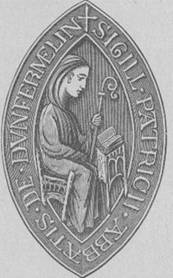
SEAL OF PATRICK, ABBOT
OF DUNFERMLINE.—The above is a fac-simile of
the wax impression of the Abbot of Dunfermline’s Seal to a Melrose Charter
of this date. This Seal, an oval one, is slightly defaced. The interior
part represents a religieux
seated, reading a Bible, it is presumed, which lies open on a table-desk
before him. Within lines round the circumference is the following legend
in old Saxon
letters:--“SIGILL-PATRICII-ABBATIS-DE-DVNFERMELIN”—that is, Seal of Patrick, Abbot of Dunfermline.
1207.—BULL FROM POPE
INNOCENT III. to Abbot Patrick of Dunfermline,
confirms to the Abbacy all its previous possessions, &c., as given in the
second Bull of Pope Lucius III. (Print.
Regist. de Dunf. p. 161.; Chal. Hist. Dunf. vol. i. p. 182.)
1208.—CLEISH CHAPEL
was about this period granted to the Abbey of Dunfermline by Malcolm, 7th
Earl of Fife. (Print. Regist. de Dunf. p. 83; also pp. 46, 108,
125, 207, 383, for Cles, Cleth, and Cleische.)
1210.—ABERCROMBIE
CHURCH.—Malcolm, 7th Earl of Fife, gave the Church of
Abercrombie, with the teinds of Quichts, &c.,
to the Abbey of Dunfermline as a free gift for ever, for his own soul and
“for the souls of his father and mother, and of his successors.” (Print. Regist. de
Dunf. p. 83.)
1212.—ERMINGARDE,
Queen of Scotland, is a witness to the Charter of Philip de Mobray, and Galiena
his wife, relative to the Church of Inverkeithing, and to which the Queen
affixes her seal. (Print. Regist. de Dunf. p. 25, No. 166, &c., Dal.
Mon. Antiq. p. 12.)
1215.—CONTROVERSY
between the Abbeys of Dunfermline and Cambuskenneth,
respecting the Chapel of Dunipace, was this
year amicably settled. (Print. Regist. de Dunf. pp. 128-130.)
THE TITHE OF POLMASE.—The
tithe of the corn of Polmase is made payable to the Abbey, by the specific
measure of a chalder of oatmeal. (Print. Regist. de
Dunf.; Dal. Mon. Antiq. p. 32.)
1216.—POPE INNOCENT
III., between the years 1206 and 1216, granted eleven Bulls or Writs of
Dunfermline Abbey. (Vide
printed Regist. Dunf. pp.
161-166.)
THE EXTENSION OF
DUNFERMLINE ABBEY commenced about this period. The Abbey, or rather
Church, founded by Malcolm and Margaret about the year A.D. 1072, had long
previous to 1216 been found unsuited for the “pomp and parade of Romish
worship.” It was resolved that the Abbey should at once be extended, and
a new building united to the walls of the original Abbey on the east that
it should be a great Cross Church, with transepts, choir, lantern tower,
presbytery, lady chapel, chapter-house and other necessary offices.
According to this resolution the extension of the
Abbey was begun and, it would appear, a slight extension of
Monastery on the south, for a contemplated increase in the number of monks
from 30 to 50, and also for suitable accommodation for receiving
strangers, visitors, c. The ground-plan on next page is from a large one,
done in 1790, by the late Rev. Mr. Syme. It may be noted that historians
and others have too frequently treated the names “Abbey” and “Monastery”
as if both names referred to one object, as it they were interchangeable.
They are not so. “Abbey” is the holy
place, the place wherein the rites and the forms of worship
were conducted; and “Monastery” is the place wherein the monks who
conduct the worship reside—where they take their meals, sleep, and perform
any secular duties.
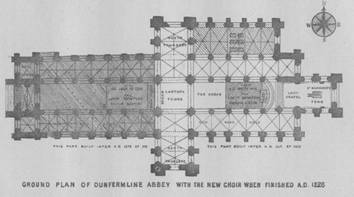
1222.—LAND AT
CRAIGMILLAR GIVEN TO THE ABBEY.—William, the son of “Henricus
de Cragmilor,” gave in pure and perpetual gift
or alms, a toft of land at Cragmilor to the
Abbey of Dunfermline. (Vide
Haddington Collections; Mackie’s Scot.
Palaces, pp. 207-208.)
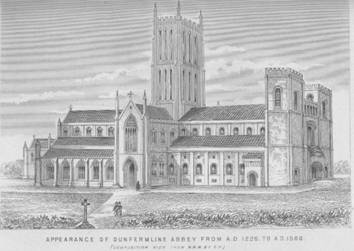
1223.—PATRICK, 5th
Abbot of Dunfermline died—“15th Kal.
Oct. obit Patricius Abbas
de Dunfermelin.” (Dart’s
Cant. Obituary.)
WILLIAM (I) elected and
consecrated Abbot of Dunfermline, as successor to Abbot Patrick. He was
the 6th Abbot, and died, after holding the abbotship for about
seven months only.
WILLIAM (II) elected
and consecrated Abbot of Dunfermline, as successor to Abbot William I.
DUNFERMLINE ABBEY
TITHES, &c.—About this period the Registrum de Dunfermlyn had
notices of “tithes of mill multures and
sequels” being levied by the Abbey; and about the same time a question had
arisen about tithing fishes. (Print.
Regist. Dunf.; Dal.
Mon. Antiq. p. 33.)
1226.—THE NEW LARGE
EASTERN CHURCH, OR CHOIR, begun circa
1216, appears to have been completed this year—“a noble structure,”
perhaps unequalled in Scotland; but the great expenses attending its
erection during the past ten years had very much impoverished the Abbey.
The Abbot applied to the Pope for relief, soliciting the patronage and
presentation to vacant churches.
BULL OF HONORIUS III.,
regarding the foregoing, refers to the augmentation of the Monastery and
the noble structure of the
extended fabric, &c. This allusion shows that the “noble structure” had
just then been completed, viz., 1226, for this Bull or Writ is dated in
the tenth year of his pontificate. This Pope in his Bull goes on to say,
in order sufficiently to sustain the honour
and the hospitality of the Abbey, he conceded and confirmed to the Abbot,
&c., the vicarages of the Churches of Hailes and Kinglassie, &c.; dated at
“Reat, I January, Pontif. Anno x”—that is A.D. 1226. (Print. Regist. Dunf. p. 167, No. 257;
see also Regist.
de Dunf. No. 130: and An. Of Dunf. date 1231.)
POPE HONORIUS III.,between the
years 1225 and 1227, granted four Bulls or Writs, to Dunfermline Abbey.
(Print. Regist. Dunf. pp.
166-168.)
VIEW OF DUNFERMLINE
ABBEY WITH THE NEW CHOIR.—There are, of course, no views extant of
Dunfermline Abbey at so early a period—nor, indeed are there any for some
hundreds of years after this period; but still, from the old prints and
sketches in the writer’s possession, some showing a portion of the north
wall of the new choir of 1228, the fragment of the lantern tower as it
stood in 1705, which along with the known architecture of the north wall
of the “Auld Kirk” (the original Abbey), a pretty correct idea can be
formed of the “noble structure” when it stood completed in 1226.
The writer of the Annals has, from the sources
just noted, drawn for the engraver the accompanying composition view,
which may be taken as a pretty correct one of the new and old fabrics from
an imaginary north-north-west point of view—say, near the top of the Kirkgate, with all the intervening houses
between this site and the Abbey swept away.
“And sure on more
majestic pile
Our northern sun did seldom smile!
Ascending from the vale below;
How nobly would it meet theeye,
When all its turrets seem’d to glow,
Midway in the morning sky!”
(Mercer’s “Dunfermline Abbey: a Poem.”)
CAPITULAR SEAL OF THE
ABBEY.—The age of this fine Seal has not been
ascertained; probably it may date from the year 1226, when
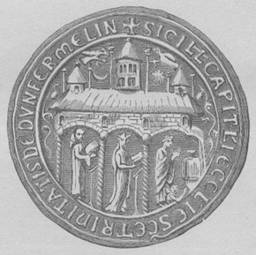
‘the Abbey was enlarged
by noble structures.” It would appear that a chapter-house was then
erected, and it may be presumed, therefore, that a special chapter-seal
was then made for “chapter business.” The Seal is a matrix one of brass,
and is 2 ¾ inches in diameter (same size as in the preceding engraving,
which is a correct representation of the obverse side of the Seal).
It has been supposed
that the design occupying the center of the Seal is a representation of
the Monastery; we rather suppose that it represents the coffer-box in
which the relics of St. Margaret were kept, and which would stand on her
shrine. There are many instances of coffer-boxes, or chests, being
“house-shaped.” If St. Margaret’s coffer-box was not so shaped, then it
is probable that the representation on the Seal may have been carved on
the front panel of the coffer-box. Mr. Henry Laing, in his “Descriptive
Catalogue of Impressions from Ancient Scottish Seals, &c., Edinburgh,
1850,” describes this part of the Seal as follows:--“This is a fine round
Seal, of an extremely interesting and curious design—perhaps intended to
represent the Monastery. A section of the lower part is given, divided
into three arches, supported by spiral columns. Beneath the first arch,
is a female figure, probably St. Margaret, holding an open book in her
hand, standing before a lectern. In the dexter arch is a monk standing
before a lectern, holding (or reading) a book. Above the roof of the
building is a crescent, an estoile, and two
birds.” Round the circumference is the following legend in old
characters:--“SIGILL CAPITL’I ECCL’IE SCE TRINITATIS DE DVNFERMELIN”—i.e.,
Seal of the Chapter of the Church of the Holy Trinity of Dunfermline.
The other half of this
matrix Seal was long missing. About the year 1847, “it was accidentally
discovered by the late Mr. Bell, of Gateshead, on the top of a barrow-load
of earth which a labourer was wheeling there.” On next page is an
accurate representation of the surface of this long lost half of the Seal
(the reverse side of it). On the Reverse of the Chapter Seal are the
figures of four Angels supporting an Aureole, within which the Saviour,
with Cruciform Nimbus, is sitting on a Rainbow, his feet resting on a
lesser one, his right hand raised as if calling to judgment, his left
holding an open book. At the dexter side is an Estoile of five points, and above the sinister hand is a
Crescent. Below the Rainbow is a Quatrefoil on the dexter, and Cinquefol on the sinister side, surrounded by
the following inscription or legend:--“MORTISL’VITEBREVIS VOXITEVENITE
DICET REPROBISITE VENITE PROBIS”—which may be rendered: “Mortis Et vite Brevis Est vox: Ite Venite Dicet Reprobis-Ite Venite Probis”—i.e.,
“Brief is the Voice of Life and Death—Go, come, it will say to the Bad;
go, come, to the good.” (Vide Laing’s
Descriptive Catalogue of Scottish Seals; Chal. Hist. Dunf. vol. ii. p. 217; Gordon’s Monasticon
p. 409.)
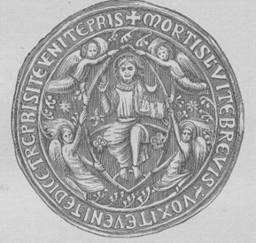
DUNFERMLINE AND
CULROSS ABBEY.—The dispute between Abbot William of Dunfermline, and Abbot
Hugh of Culross, relative to payments due to the former Abbey for the
Church of Abercrombie, in the jurisdiction of the latter Abbey, is the
year amicably settled by these Abbots, the Abbey of Culross agreeing to
pay 15 marks of silver yearly to the exchequer of Dunfermline Abbey.
(Print. Regist. Dunf. pp.
126, 127.)
1227.—A FREE WARREN
GRANTED TO THE MONKS.—Alexander II. granted to
the Monks of Dunfermline Abbey a free warren throughout their lands at
Musselburgh, and prohibited every one from hunting or trespassing within
the warren on the penalty of 10. (MS. Monastica Scotiae, vol. ii. p. 724.)
1228.—A TOFT OF LAND
in Leith was, about this period, given to
Dunfermline Abbey, by Thomas de Lastalric (Restalrig,
near Edinburgh). Print. Regist. Dunf. p. 106, No. 188.)
A TOFT OF LAND in
Haddington, given to Dunfermline Abbey by David de
Lyndeseya (Lindsey). (Print.
Regist. Dunf. p. 105, No. 191.)
1229.—THE ABBEY OF
DUNFERMLINE AND THE VICAR OF MUSSELBURGH.—In the dispute between the Abbey
and the Vicar of Musselburgh, the Bishop of St. Andrews determines that
the Vicar shall have all offerings and small tithes belonging to his altarage, excepting the fishes of every sort,
and the tithes of mills belonging to the monks, for which the Vicar must
pay to the Abbey of Dunfermline 10 merks yearly. (Print.
Regist. Dunf. p. 69, No. 114; Dal.
Mon. Antiq. p. 31.)
1230.—CHARTULARY OF
DUNFERMLINE, now called the “Register of Dunfermline,” appears to have
been begun as early as this period. The Chartulary is and has been in the
Advocates’ Library, Edinburgh, for nearly 20 years. It has modern
binding, and is in good condition. First Charter by David I., 1128; last
Charter by George Dury, Abbot of Dunfermline, in 1557.
1231.—THE ABBEY
ENLARGED by a “Noble Structure,” and the number of Monks increased from 30
to 50.—Under date 1226, notice is taken of the
enlargement of Dunfermline Abbey by the erection of a more noble building,
viz., the Choir. This year, 1231, the newly erected noble structure is
again noticed, along with an increase of 20 monks. The following is a
free translation of the Charter of 1231 referring to the new Choir and
increase of monks. This Charter is titled “Confirmacio Gilberti Dunkeld Epi
de Ecclia de Molin”:--
“My beloved son, the
Abbot and Convent of Dunfermline have made known to me that, in the
aforesaid Monastery, which they have anew enlarged, not without great
expense and debt, with a fabric of a nobler structure, specially for the
improvement of the worship of God: and they have increased the number of
servitors (monks), so that when there used to be thirty, fifty monks are
now kept, their own means not sufficing for the support of these, and for
the reception of strangers, poor people, and guests, they often undergo
the burdens of debts; whence they have made humble supplication, because
in certain churches of your diocese they hold the right of partronage, in
order that the worship of God may not perish altogether in the said
Monastery from want of necessaries or hospitality be diminished, that we
should assign to their special use a certain part of the foresaid churches
for this purpose. Wherefore, &c,--Given at the Lateran, July 6th,
in the 4th year of our Pontificate” (1231).
The foregoing Writ, or
Bull, is from Pope Gregory IX. To Gilbert, Bishop of Dunkeld. The Abbot
and Convent had, it would appear, “made humble supplication for the
patronage of certain churches in Moulin, in the diocese of the Bishop.”
(Vide Regist. de Dunf. No.
130, pp. 76, 77.) This is the Writ or Bull Dalyell refers to in his Monastic Antiquities at p.
15. He had evidently overlooked the Writ or Bull of 1226. (Regist.
de Dunf. No. 257, p. 167.)
1231.—ABBEY LAND,
BOUNDARIES AT DUNDUFF.—In a deed of perambulation of the lands belonging
to the Abbey of Dunfermline, and those of David
Durward of Dunduff, dated 1231, done to
determine their respective boundaries, the names of the freemen who
composed the jury, and of the native bondmen residing on the disputed
lands, who were the witnesses, are readily distinguished from each other.
Among the names of the free men (who are chiefly Saxon and Norman) are
Constantine de Lochor, Philip de Loch, John of Oberville, &c; among the bond men (who are
Celtic) are Gillecostentin, Gillethomas, Brindin Camb, Gilleserf mac Rolf, Gillecomb mac Melg, John Trodi, Riscolog, Gillandres, Seth mac Lood, Gillepatric mac Machin
(meaning servant of Constantine, of Thomas, of Andrew, c.). John of Oberville, one of the freemen, was probably
the progenitor of William of Oberville, of Pettencrief, who in 1291, granted the Coal
Charter to the Abbey. (Print. Regist.
Dung. P. 111; also Chal.
Hist. Dunf. vol. i. p. 218.)
CLEISH.—Gilbert de Cles agreed to pay annually to the House of
Dunfermline (the Abbey) 10s. for land between Cleish and the Forest of
Outh, according to a precept of King Alexander II. (Print. Regist. Dunf. p. 108, No.
192.)
CREBARRIN LANDS.—Adam,
the son of Patrick of Crebarrin, John of Crebarrin and Alanus
de Faud, have Charters in the Register of Dunfermline of the
date regarding the rights to these lands, which they convey to the Church
of the Holy Trinity, and the monks there serving God, &c. (Print. Regist Dunf. pp. 102-106.)
1234.—THE CHURCH OF
MELVILLE, granted to the Abbey in 1197, was this year confirmed in its
right, by Pope Gregory IX., in his general Confirmation Charter. (Print. Regist. Dunf. pp. 174-177.)
POPE GREGORY IX.,
between the years 1230 and 1234, granted 13 Bulls or Writs, to Dunfermline
Abbey. They chiefly relate to 13 Churches and Chapels under the patronage
of the Abbey. (Print. Regist. Dunf. pp. 168-177.)
THE TEINDS OF
KINGLASSIE were, in 1234, “mortified by William, Bishop of St. Andrews, Deo, S. Margarete,
et monachis de Dunfermline.”
KINGLASSIE AND
CONSTANTINE LOCHOR’S RENOUNCEMENT.—This year
Constantine Lochor, with the consent of David,
his son and heir, and Philip his brother, renounced his claim to
Kinglassie in favour of the Abbey of Dunfermline. (Print.
Regist. Dunf. p. 101; Sibblad’s
Hist. Fife, p. 374.)
1236.—DOLLAR FOREST
GIVEN TO DUNFERMLINE ABBEY BY ALEXANDER II.
“Alexander, by the
grace of God, King of Scots, to all the good men of his whole land,
greeting,--Let them know that we have granted to the Abbot and Convent of
Dunfermline, that they hold their land of Dollar in free forest for ever.
Therefore, we strictly forbid any one without their leave to cut wood or
hunt in the said land, upon our full forfeiture of ten pounds.—Witnesses:
WALTER, the son of Alan the Steward, Fusticiar
of Scotland; W. CUMIN, Earl of Menteth; WALTER
OLIFARD, Fusticiar of Lothian.—Given at Scone,
20th October, Anno Regni Dni Regis xxiii. 1236.” (Print. Regist Dunf. pp. 43, 44.)
1237.—DOLLAR AND
DUNFERMLINE.—The following is a translation of
a short Charter of Alexander II. relating to
Dollar and Dunfermline:--
“Alexander, by the
grace of God, King of Scots, to all the good men of his whole land,
greeting.—Be it know to all present and to come, that we, in exchange for
the alms which the Monks of Dunfermline used to receive in our lordship at
Kinghorn and Crail, as well of wheat, oatmeal,
malt, corn, and straw, as in money, and likewise in exchange of all the
dues they used to receive in our kitchen and that of the Queen, our
spouse, have given and granted for charity, and by this our Charter have
confirmed to God and the Church of the Holly Trinity of Dunfermline, and
the Monks there serving God, and perpetually to serve there, all our lands
of Dollar, in the fief of Clackmannan, to hold and to keep for the said
Monks, in free and perpetual alms, by the same right boundaries and rights
by which our tenants held the same land of us on the day of this grant,
freely, quietly, fully, and honourably, doing
the lawful service which pertains to the same land of Dollar.—Witnesses:
PATRICK, Earl of Dunbar; WALTER, the son of Alan, the Steward Fusticiar of Scotland; WALTER CUMIN, Earl of Menteth; WALTER OLIFARD,
Fusticiar of Lothian; ALAN DURWARD, WALTER BYSET, BERNARD
FRASER.—Given at Stirling, 27 December Anno Regni Dni Regis xxiii”—viz., A.D. 1237. (Print. Regist. Dunf. p. 43.)
THE VICARS OF PERTH
AND DUNFERMLINE ABBEY.—In a controversy between the Vicars of Perth and
the Abbey of Dunfermline of long standing, the Bishop of St. Andrews
decided that, on payment of 50 merks to the Abbey, the Vicars shall be
responsible for the Episcopal and all other burdens incumbent on the
Church of Perth; and to all offerings, and all other things that may arise
from fortuitous occasions and circumstances; and also to the tithes of
Lent, paid in money. (Print. Regist.
Dunf. pp. 64, 65, No. 108.; Dal.
Mon. Antiq. p. 35.)
1238.—WILLIAM (II.),
the Abbot of Dunfermline, died. (Chron.
Melrose, p. 148.)
GAUFRID (II.) Prior of
the Abbey, elected and consecrated Abbot of Dunfermline, as successor to
Abbot William (the 7th Abbot).
1240.—KIRKCALDY
CHURCH.—This year, David, by Divine permission, Bishop of St. Andrews,
bestows the Church of Kirkcaldy on the Abbey, the Abbot and brethren to
provide Vicars, “qui onera ecclesiae sustinebunt, praeterquam hospitium episopi
de quo dicti abbas
et conventus respondebunt”—i.e.,
Who will bear the Church burdens besides the entertainment of the Bishop,
as to which the said Abbey and Convent will be responsible. (Print. Regist. Dunf. p. 116, No. 117; Dal.
Mon. Antiq. pp. 67, 68.)
KINGHORN
CHURCH.—David, by Divine permission, Bishop of St. Andrews, in his Charter
of this date, confirms to Dunfermline Abbey its right to the Church of
Kinghorn, dated St. Andrews, 12th January, 1240. (Print. Regist. Dunf. pp. 71, 72, No.
119.)
WYMET CHURCH.—David,
the Bishop in the same Charter, confirms to the Abbey, its rights in the
Church of Wymet. (Print. Regist. Dunf. pp. 71, 72, No.
119.)
GAUFRID (III.), Abbot
of Dunfermline, died. (Chron.
Melrose, p. 148.) He appears to have been about two years and
seven months in office, and is the last of the name.
1241.—ROBERT OF
KILDELETH, or Keldelecht, elected and
consecrated Abbot of Dunfermline, as successor of Abbot Gaufrid. (This
Robert is the 8th Abbot.)
1243.—DUNFERMLINE
ABBEY BECOMES A MITRED ABBEY.—By a Bull or Writ of Pope Innocent IV., in
the Register of Dunfermline,
he confers on the Abbot of Dunfermline the honour
and privilege of wearing, or using the Mitre,
the Ring, and other pontifical ornaments—(de mitra
et annulo et certis
epics.). These other, no doubt refer to the crosier, the shoes, &c. This
Writ is addressed to “my sons, the Abbot and
conventual brethren of Dunfermline.” (Print. Regist. Dunf. p. 180, No.
179.)
LORD ABBOT OF
DUNFERMLINE.—By virtue of the foregoing Writ of Pope Innocent IV., the
style or title of the Abbot is “Lord Abbot,” and continued so until the
Reformation, in 1560, when “all Romish practices and titles ceased.)
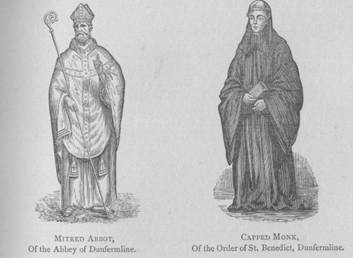
CAPS or BONNETS, may
be used by the Monks of the Abbey.—Pope Innocent IV., in a Writ, sent to
the Abbot in the first year of his pontificate, concedes to a request
which the Abbot and Convent had solicited, viz., he says, “that, on
considering the frigid region” (cold climate) “where the Abbey is
situated, he consents to allow the monks the privilege of wearing caps, or
bonnets, suitable to monks of their Order; but they must not forget to
preserve due reverence at the elevation of the Host, at the Eucharist, and
other observances.” This Writ is titled “De pileis”—i.e.,
concerning the Caps, Hats, or Cowls. The Writ is dated “Lyons, 7th
May,” in the first year of his pontificate,
viz., 1242. (Print. Regist. Dunf. p. 178, No. 275; Dal.
Mon. Antiq. pp. 15, 16.) It would
appear that their caps, or cowls, were made of leather, as several
fragments of “bowl-shaped leather” were found amongst the mounds of
rubbish which had for centuries lain on the site of the Choir, during the
leveling of the ground, in 1817, for the present Abbey Church.
1245.—REGARDING THE
MIRACLES AND CANONIZATION OF MARGARET, CONSORT OF MALCOLM III.—In
the “Register” of the Abbey there is a copy of a Bull or Writ, from Pope
Innocent IV., regarding “the miracles of Margarite the Queen.” It is
addressed to the Bishop of St. Andrews, Dunkeld, and Dunblane, and is
evidently the result of a letter which he had had from King Alexander II.,
soliciting that the body of Margaret, of blessed memory, should be
enrolled in the catalogue of the saints, as her body had shown infinite
bright, light-flashing, coruscating miracles; but as the King’s letter to
him (the Pope) had given no evidence of this, he directs the above-named
Bishops to make strict inquiry regarding the matter, and commanding them
to reduce what was proved to writing, attested by their seals, and
transmitted to him by a trusty messenger. Dated at “Lug 5 Aug.” 2nd
year of the pontificate, 1244. (Print. Regist. Dunf. p. 181, No.
281.)
“THE PRIVILEGES” OF
EXCOMMUNICATION granted to the Abbey by Pope Innocent IV. The following
is a translation of the Charter conveying “the privilege”:--
“Innocent, bishop,
servant of the servants of God, to his beloved sons, the abbot and convent
of the monastery of Dunfermline, of the Order of St. Benedict, of the
diocese of St. Andrews, salutation and apostolic benediction,--Since, as
has been intimated to us on your part, certain ecclesiastical judges,
after binding with the chain of excommunication some who are disobedient
unto them, presume to fulminate their sentences of excommunication against
those participating with such excommunicated persons—not only in their
crime, but even in any respect—We, having given heed to your devout
prayers, by authority of these presents, Grant you an indulgence, if at
any time you or your servants happen to hold intercourse with such
excommunicated persons, that ye shall on no account be bound with the cord
of the greater excommunication, provided ye be no partakers with the
guilty in their crime. Let it be lawful for none to infringe upon this
our indulgence, or to oppose it by a daring rashness. If any one presume
to attempt this, let him know that he shall incur the indignation of
Almighty God, and of the blessed Peter and Paul, his apostles.—Given
at Lyons, 5th calend. May”
(28th April), “and 2nd year of our
pontificate.” (Print. Regist. Dunf. p. 599; Register, pp. 142, 170, 179, 262, 420,; also Chal. Hist. Dunf. vol. i. p. 505; and at dates 1316 and 1342, Annals of Dunf., &c.)
REGARDING THE MIRACLES
attributed to the body of Queen Margaret. In Registrum de Dunfermlyn, there
is a copy of a second Bull from Pope Innocent IV. Regarding the alleged
miracles, and from its tenor it would appear that the Bishops of St.
Andrews. Dunkeld, and Dunblane, although they had investigated the matter,
had neglected to record in their missive the names and the words of the
witnesses and in consequence of the he (the Pope) refused to accede to the
King’s request. This Bull is addressed to his “venerable brethren, the
Bishops of St. Andrews and Glasgow.” The Bishops of Dunkeld and Dunblane
are not named in it (singular). Dated at “Lug 1st Augt,” and in the
3rd year of the pontificate, 1245. (See Print. Regist. Dunf. p. 183, No.
285.) After this the miracle affair rests until 1249, when it once more
became the subject of investigation. (See date 1249.)
1247.—ORGAN.—It
would appear that, as early as this period, a large organ was erected in
Dunfermline Abbey, at the junction of the Old Church with the New Choir,
for the daily Abbey service.
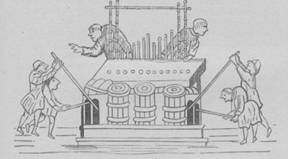
The organ is, however,
not mentioned in history before 1250, in connection with the
ecclesiastical procession at the “Translation,” but then it is introduced
to notice as being in use, and for some time previous, no doubt. (Vide “Translation of St. Margaret,” An. Dunf. date, 1250.)
The above engraving
represents the appearance and the working of an organ of 1240. It is
taken from the “Psalter of Edwin” in the Cambridge Library. Lubkes, in his “Ecclesiastical Art.” Says that
“the organs” of this early period “were very simple, and the keys were so
heavy that they could only be pressed down by the elbow, or the complete
fist;” and Hargreaves,
in his “Miscellania,” notes that “the blowing
power of the middle-age organs came out of the eight arms of four strong
men,” who, when at work kept pumping away at their levers, &c., as shown
in the engraving. |

